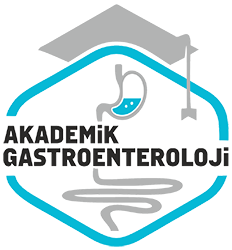Nisan 2020
Helicobacter pylori enfeksiyonu tanisinda kullanilan invaziv yöntemlerin duyarlilik ve özgüllüklerinin değerlendirilmesi
Helicobacter pylori enfeksiyonu tanisinda kullanilan invaziv yöntemlerin duyarlilik ve özgüllüklerinin degerlendirilmesi
- Ana Sayfa
- Sayılar
- Nisan 2020
- Helicobacter pylori enfeksiyonu tanisinda kullanilan invaziv yöntemlerin duyarlilik ve özgüllüklerinin değerlendirilmesi...
Özet
Giriş ve Amaç: Helicobacter pylori yaklasik 3.5 mikron uzunlugundave 0.5 mikron genisliginde, spiral şekilli, mikroaerofilik, gram negatif birbakteridir. Dünya popülasyonunun yaklasik yarisi Helicobacter pylori ileenfektedir. Helicobacter pylori, gastrit, gastrik ve duodenal ülser, gastrikadenokarsinoma ve mukoza ile ilişkili lenfoid doku lenfomasinda birincil patojen olarak bildirilmektedir. Bu bakteri gelismekte olan ülkelerdeönemli bir halk sagligi sorunudur. Helicobacter pylori tanısında endoskopi gerektiren invaziv ve gerektirmeyen noninvaziv tanı testleri mevcuttur.Bunlar; hizli üreaz testi, histopatolojik inceleme ve kültür invaziv yöntemlerdir. Bu çalışmada amacımiz Helicobacter pylori enfeksiyonu için dahaönce tedavi almamis hasta grubunda hizli üreaz testi, histopatolojik de-gerlendirme ve kültür sonuçlarının karsilastirilmasi ve bu yöntemlerin kültür altin standart yöntem olarak değerlendirildiginde sensitivite ve spesifitelerini belirlemektir. Gereç ve Yöntem: Hastanemiz gastroenterolojikliniginde dispepsi ön tanısı ile endoskopi yapılan 18-65 yaş arasi 55’i(%55.6) kadın, 44’ü (%44.4) erkek toplam 99 hasta çalışmaya alinmıştır.Endoskopide antrumdan kültür, dokuda üreaz ve histopatolojik inceleme için toplam dört biyopsi örneği alinmıştır. Bu örneklerin iki tanesikültür için kullanilmıştır. Enfeksiyon tanısında altin standart olarak; tekbasina kültürün pozitif olmasi ya da kültürün negatif olduğu durumlardakullanılan iki testin (histopatolojik inceleme ve hizli üreaz testi) pozitifolmasi kabul edilmıştır. Bulgular: çalışmada 18-65 yaş arasi (yaş ortalaması 44.42±12.53), 55’i (%55.6) kadın, 44’ü (%44.4) erkek toplam 99hasta değerlendirilmıştır. Endoskopik olarak 91 (%92) hastada gastrit,8 (%8) hastada gastrik ülser tespit edildi. 38 (%38.3) hastada kültürdeüreme, 75 (%75.7) hastada hizli üreaz testi pozitifliği ve 71 (%71.7)hastada histopatolojik inceleme pozitifliği bulunmustur. Buna göre 99hastanın 63 (%63.6) tanesinde altin standart kriterlerine göre Helicobacter pylori pozitif bulunmustur. Hastaların kültür, hizli üreaz testi vehistopatolojik inceleme yöntemlerinin duyarlilik ve özgüllükleri sırasıyla%60.3 ve %100, %100 ve %66.6, %98.4 ve %75.0 olarak saptanmıştır. Sonuç: Helicobacter pylori enfeksiyonu tanısında kullanılan farkli özgüllük ve duyarliliga sahip birçok yöntem mevcuttur. Ancak bu yöntemlerarasından yapilacak olan seçim, amaca ve klinik sartlarina göre degisıklıkgöstermektedir. Çalışmamızin bulgulari, endoskopik yöntemlerin uygulanabildigi durumlarda, erken tanı ve tedavi karari için hizli üreaz testi kullanilarak hastalığın tedavisinin planlanabilecegini destekler niteliktedir
Abstract
Background and Aims: Helicobacter pylori is a helical Gram-negativemicroorganism frequently detected in people worldwide. It is the causeof 90% of duodenal ulcer cases and 60%-70% of peptic ulcer cases.The World Health Organization also indicated that Helicobacter pylori is the most common reason of mucosa-associated lymphoid tissuelymphoma and gastric malignancies. Helicobacter pylori infection is diagnosed by using various methods, such as endoscopy to obtain tissuesamples, histopathological evaluation, bacterial culture, rapid ureasetest, and polymerase chain reaction, but they are invasive methods forthe direct detection of pathogens. Our study aimed to compare thediagnostic value of histological examination, bacterial culture, and rapid urease test for detecting Helicobacter pylori infection in untreatedpatients and to determine the sensitivity, specificity, and negative andpositive predictive values of these tests. Materials and Methods: Ninety-nine patients who were examined because of dyspeptic complaintsand scheduled for an upper gastrointestinal endoscopic examinationwere included in this study. Four biopsies (antrum) were obtained fromeach patient and examined via a rapid urease test, a histopathologicalevaluation, and a bacterial culture. As the gold standard in the diagnosis of infection, it was accepted that either the culture was positive,if the culture was negative, or the two other tests were both positive.The specificity and sensitivity of these methods were compared. Results: Of the 99 biopsy specimens obtained from the patients withdyspeptic complaints, 71 (71.7%) were positive for Helicobacter pyloriduring histopathological evaluation, 75 (75.7%) were positive for Helicobacter pylori during rapid urease test, and 38 (38.3%) were positivefor Helicobacter pylori during bacterial culture. The sensitivity and specificity of the tests were as follows: rapid urease test, 100% and 66.6%;histopathological evaluation, 98.4% and 75.0%; and bacterial culture,60.3% and 100%. Conclusion: The diagnostic methods used to identify Helicobacter pylori infection were compared, and results indicatedthat in comparison with bacterial culturing as the gold standard forthe detection of Helicobacter pylori infection. This study showed thatdisease treatments could be planned by conducting a rapid urease testfor early diagnosis, and treatment decision could be made through endoscopic methods.



